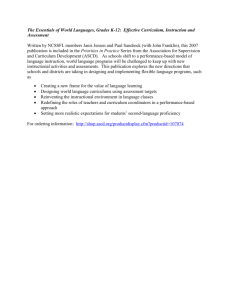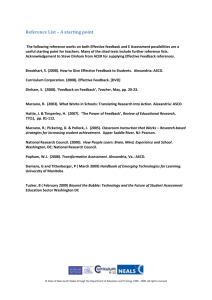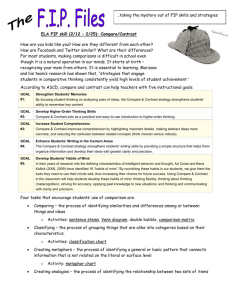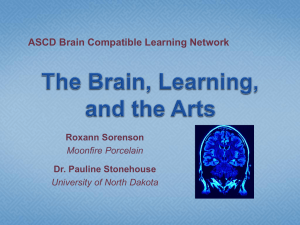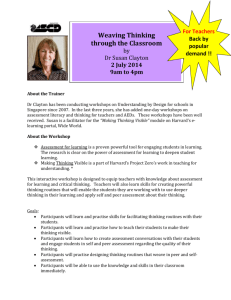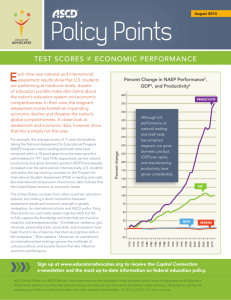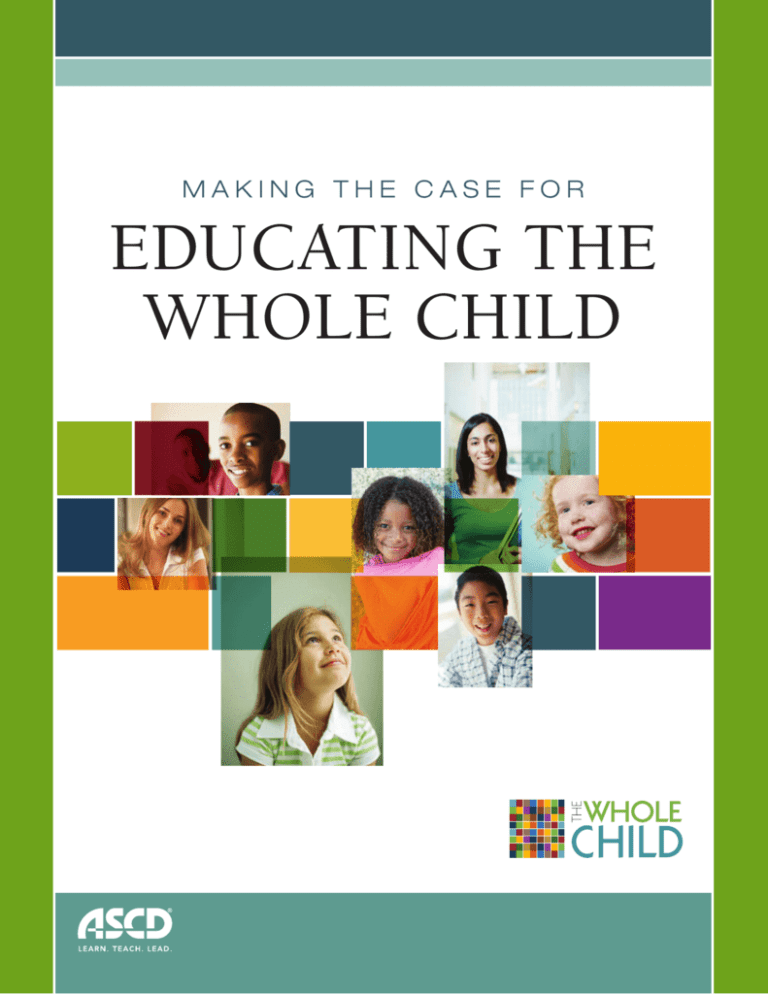
MAKING THE CASE FOR
EDUCATING THE
WHOLE CHILD
Association for Supervision and Curriculum Development
www.ascd.org
The 21st Century Imperative
W
e live in a global economy that requires our students to be prepared to think both
critically and creatively, evaluate massive amounts of information, solve complex
problems, and communicate well. A strong foundation in reading, writing, math, and other core
subjects is still as important as ever, yet by itself is insufficient for lifelong success.
For too long, we have committed to time structures, coursework, instructional methods, and
assessments designed more than a century ago. Our current definition of student success is too
narrow. It is time to put students first, align resources to students’ multiple needs, and advocate
for a more balanced approach.
What works best for children? What must we all—educators, families, policymakers, and
community members—do to ensure their success? Answering those questions pushes us to
redefine what a successful learner is and how we measure success. A child who enters school
healthy and feels safe is ready to learn. A student who feels connected to school is more likely
to stay in school. All students who have access to challenging and engaging academic programs
are better prepared for further education, work, and civic life. These components must work
together, not in isolation. That is the goal of whole child education.
The demands of the 21st century require a new approach to education policy and practice—
a whole child approach to learning, teaching, and community engagement. Measuring academic
achievement is important and necessary; no one is arguing otherwise. But if we fail to move
beyond a narrow curriculum and accountability system, we will have failed to adequately prepare
children for their futures.
ASCD—in partnership with state and local leaders—is helping schools, districts, and
communities across the country move from a vision for educating the whole child to action.
States and school districts are adopting policies and practices to better educate the whole child,
but we can do more. This publication makes the case for why we need to educate the whole
child and provides clear examples of how it’s taking place.
To find out more and to help educate the whole child, visit www.wholechildeducation.org.
2
Making the Case for Educating the Whole Child
ASCD’s Whole Child Tenets
Each student learns
in an environment
that is physically and
emotionally safe for
students and adults.
Each student enters
school healthy and
lear ns about and
practices a healthy
lifestyle.
Each student is
actively engaged
in learning and is
connected to the
school and broader
community.
www.ascd.org
Each student has
access to
personalized lear ning
and is supported
by qualified, caring
adults.
Each student
is challenged
academically and
prepared for success in
college or further study
and for employment and
participation in a global
environment.
3
Making the Case for Educating the Whole Child
Students Must Be
HEALTHY
R
esearch confirms that students do better in school when they are emotionally and physically healthy. They miss fewer
classes, are less likely to engage in risky or
antisocial behavior, concentrate more, and
achieve higher test scores. Unfortunately, too
many students go to class in less than optimal health.
What the Data Tell Us
• Regular physical activity can improve the
health and quality of life of people of all ages
(HealthyPeople.gov, n.d.); however, only 17
percent of high school students currently
meet the recommended daily amount (Eaton
et al., 2010).
• Over the past three decades, childhood
obesity rates in the United States have tripled. Today nearly one third of U.S. children are overweight (U.S. Centers for
Disease Control and Prevention, 2008),
and almost 17 percent of children and
adolescents are obese (Ogden, Carroll,
Kit, & Flegal, 2012).
• Research shows that programs offering
breakfast at no cost to all children, regardless
of income, during the first part of the school
day dramatically increase student participation in school breakfast (Food Research and
Action Center, 2009). However, only 9.7 million of the 20 million low-income students
who are eligible for a school breakfast receive
it (Share our Strength, 2012).
• Improved health can also improve attendance at school. Higher rates of absenteeism
have been reported for those students who
are overweight; suffer from asthma; or have
poor health status, diet, or lack of sleep.
Studies have also shown that health-related
absenteeism can be reversed by increasing
access to services and increasing physical
activity. (Basch, 2010)
• Research shows that one of five
children and adolescents experiences
symptoms of a mental health illness
(Eaton et al., 2010), and as many as
80 percent may go untreated (Breslau,
2010). Children and adolescents with
mental disorders are at much greater risk for
­dropping out of school and suffering longterm impairments (Breslau, 2010).
4
Making the Case for Educating the Whole Child
Case In Point . . .
Health and Wellness Are
Key to School Success
Hilton Head Island Elementary (HHIE), an
International Baccalaureate World School
located in South Carolina, was awarded the
South Carolina ASCD Whole Child Award
for its efforts in promoting wellness and
healthy choices in students and staff.
The school’s Healthy Choices–Eat Smart/
Move More program has changed the
cafeteria menu to include more appetizing
and healthy food choices for the school
community. The school food service
company is helping the school in these
efforts by offering more student-choice
entrees, vegetarian trays, and healthy snacks
and using more appetizing preparations for
the diverse student population.
Additionally, the faculty at HHIE are
working with experts to develop curriculum
in gardening and nutritional awareness. The
health and well-being behaviors HHIE
students are learning now prepare
them well to take charge of their own
health and well-being in the future.
Community Collaborations
Promote Healthy Lifestyles
Among Students
Batesville Community School Corporation,
a school district in Batesville, Ind., promotes
a strong emphasis on health and boosts this
with collaborations in its local community.
Batesville, an ASCD Healthy School
Communities mentor site, has established
multiple links between the school district and
local community.
Through the local hospital and the local
Food and Growers Association, the school
has been able to improve cafeteria food
offerings and expose students to more fruits
and vegetables. This is complimented by
ventures with local organizations to increase
physical activity and improve health across
the community, including the Presidential
Challenge for Families, Indiana Mini-Marathon
Team Batesville, Active For Life, and the
development of a School Garden.
These efforts to improve physical activity and
nutrition and provide safe places for students
to socialize have resulted in healthier students
and a safe, connected community.
5
Making the Case for Educating the Whole Child
Students Must Be
SAFE
F
eeling safe at school translates into
higher academic achievement,
increased student well-being, and greater
engagement, according to numerous
studies. Children who don’t feel safe
can’t concentrate on their studies, don’t
connect with their classmates, or don’t go
to school at all.
What the Data Tell Us
• Students engaged in school-based social
and emotional learning attained higher
grades and scored 11 percentile points
higher on academic achievement tests
than peers who did not engage in such
learning (Collaborative for Academic,
Social and Emotional Learning, 2008).
• Victims of crime or violence at school are likely
to experience loneliness, depression, and adjustment difficulties, and they are more prone to
truancy, poor academic performance, dropping out
of school, and violent behaviors (Robers, Zhang,
­Truman, & Snyder, 2010).
• Twenty percent of youth report being bullied on
school grounds in the past 12 months (Eaton et al.,
2012), and nearly 6 percent of students skipped
school at least once in the past 30 days because of
concerns for their own safety (Eaton et al., 2012).
• Eight out of 10 lesbian, gay, bisexual, or transgender students report being verbally harassed, and
more than one-third were physically harassed in
the past 12 months (Kosciw, Greytak, Bartkiewicz,
Boesen, & Palmer, 2012).
6
Making the Case for Educating the Whole Child
Case In Point . . .
School Creates Safe,
Supportive “Family”
New Jersey’s Safe and
Civil Schools Initiative
Named a 2011 National School of Character
by whole child partner the Character
Education Partnership, Roosevelt Primary
School in Ferndale, Mich., is committed
to providing a successful, appropriate
foundation to educate all children. The
school has created a caring community—
or, as staff and parents would say, a family.
State education leaders in New Jersey
are committed to making sure students
entering public school feel safe, engaged,
and connected. They want students to
see school as a place where they can
learn and contribute to the world around
them. To accomplish this, students receive
coordinated and continuous support to
strengthen their social and emotional skills
and enhance positive character traits.
The intent is to reduce substance abuse
and bullying, develop positive learning
environments, and improve students’
academic performance.
Principal Dina Rocheleau says, “My staff is
so committed to making this work, and they
have such a connection with each other.
Even when they have a conflict with one
another, they know how to resolve it.”
Under the guidance of this principal, staff
created classroom climates that teach
children essential values. They moved to
a relation-based approach that focuses on
love, safety, and the whole child.
Preliminary results highlight that the
initiative has a significant effect on reducing
suspensions and violence and has shown to
be effective in developing a positive climate,
even in difficult school contexts (M. J. Elias,
personal communication, 2012).
7
Making the Case for Educating the Whole Child
Students Must Be
ENGAGED
T
o learn at their best, students must be
engaged and motivated. Substantial
research shows that students who feel both
valued by adults and a part of their schools
perform better academically and also have
more positive social attitudes, values,
and behavior. Plus, they are less likely to
engage in drug use, violence, or sexual
activity. After-school programs can promote
academic achievement, but their success
requires targeted investment, stakeholder
commitments, focused academic support,
quality programming, and a process
of continual improvement.
What the Data Tell Us
• 66 percent of surveyed students reported
being bored in every class or at least every
day in school. Of these students, 98 percent
claimed that the material being taught was
the main reason for their boredom; 81
percent thought their subject material was
uninteresting, while two out of three students
found that the material lacked relevance.
(Yazzie-Mintz, 2010)
• In 2009, only 75 percent of U.S. public
high school diploma recipients graduated on
time, indicating that one quarter of public
high school students either did not graduate on time, received alternative completion
certification, or dropped out (Stillwell, 2010;
America’s Promise, 2012).
• As students age, their level of school
engagement tends to decrease—from a peak
in elementary school through a significant dip
in middle and early high school to a slight
increase in later high school (Lopez, 2010).
8
Making the Case for Educating the Whole Child
Case In Point . . .
It Takes a Village
One of the key factors that strengthens student,
staff, and family engagement at Westside Village
Magnet School, in Bend, Ore., is relationships.
At Westside Village, all stakeholders are
endowed with a sense of belonging and find
space to collaborate to support an inclusive and
democratic learning environment that meets the
individual needs of each child.
With a well-rounded, hands-on curriculum
that is integrated with the arts, health and
wellness, civics, and outdoor “adventure
learning,” students have not only achieved high
test scores, but they have also learned to be
advocates for their own learning needs.
Each year West Village students’ passions and
personal learning goals—whether they are
environmental, social, or local issues—are
integrated directly into the curriculum.
The school uses data-benchmarking systems
to regularly monitor student achievement
and provide differentiated instruction to
support learning for all to provide the most
engaging learning environment for each
student. In addition the school provides a
Child Enrichment Program, which offers
after-school activities—including karate,
drama, art, yoga, global celebrations,
basketball, scrapbooking, mad science,
chorus, cartooning, and a cooking club—to
engage students’ interests and talents.
Students who need extra support are
referred to a Target Team that offers
additional “check-in, check-out” services,
social skills training, and in-school
counseling or wrap-around services for
the family. Close links back into the
local community provide cohesion and a
supportive setting for the school and its
students.
Engaged Learning
Community Creates Safe,
Supportive, Challenging
Environment for Students
Ashton Elementary School, located in
Cumberland, R.I., was the winner of the Rhode
Island ASCD Whole Child Award for developing
engaging and meaningful learning opportunities
for its K–5 students, parents, and teachers.
9
Making the Case for Educating the Whole Child
Students Must Be
SUPPORTED
I
n addition to improving students’
academic performance, research shows
that supportive schools also help prevent
a host of negative consequences, including
isolation, violent behavior, dropping out of
school, and suicide. Central to a supportive
school are teachers, administrators, and
other caring adults who take a personal
interest in each student and in the success
of each student.
What the Data Tell Us
• Learning environments that focus on
caring student-teacher relationships,
students’ social and emotional needs, and
high expectations result in students who
perform better academically; are more likely
to attend school; and have significantly
lower rates of emotional distress,
violence, delinquency, substance
abuse, and sexual activity
(Collaborative for Academic, Social and
Emotional Learning, 2008).
• When asked to identify words or phrases
that best described the teacher who had the
most positive influence in their life, people in
the United States responded with the word
caring, followed by encouraging, interesting,
personable, and of high-quality (Bushaw &
Lopez, 2010).
• A student-counselor ratio of 250 to
1 is recommended by the American
School Counselor Association, though the
nationwide average is 471 to 1 (American
School Counselor Association, 2012).
• Of students who have considered dropping
out, 16 percent identified “No adults in
the school cared about me” as a reason for
thinking about dropping out, and 9 percent
of the respondents stated that “Adults in
the school encouraged me to drop out”
(Yazzie-Mintz, 2010).
10
Making the Case for Educating the Whole Child
Case In Point . . .
Learning by Doing, Part of
a Real-World Curriculum
A personalized and nurturing learning
experience for all students is the foundational
goal at Quest Early College High School, in
Humble, Tex., winner of the 2011 Vision in
Action: The ASCD Whole Child Award.
Through community partnerships and
collaborations, students learn by doing by
taking part in service learning, internships,
and social actions that allow them to
understand the relevance of what they
learn. Students take ownership of their own
learning by designing their own physical
fitness goals and activities, beginning college
coursework while in high school that can
earn them up to 60 college credits, and
designing their own senior capstone research
projects that reflect a social issue that has
personal meaning.
relationships, and demonstrate decision
making and responsible behaviors for success
in school and life. Research indicates that
this improves students’ social and emotional
development, readiness to learn, classroom
behavior, and academic performance.
New York and California have policies for
social and emotional learning, and large
school districts like Anchorage, Alaska;
Austin, Tex.; Chicago, Ill.; Cleveland,
Ohio; Nashville, Tenn.; Oakland, Calif.;
Sacramento, Calif.; and Washoe County,
Nev., are implementing social and emotional
learning strategies districtwide.
States and Districts
Embrace Social and
Emotional Learning
Illinois was the first state to adopt learning
standards in social and emotional learning.
Social and emotional learning helps children
develop awareness of their emotions and
better manage them, set and achieve personal
and academic goals, use social-awareness
and interpersonal skills to maintain positive
11
Making the Case for Educating the Whole Child
Students Must Be
CHALLENGED
T
o succeed in college, other
postsecondary education, and the
workplace, students need higher-level
thinking, communications, and problemsolving skills as well as knowledge of the
world and its people. These are all products
of a curriculum that challenges students to
work harder as they investigate a wide range
of real-world subjects. What’s more, our
high school graduates who pursue college
must be adequately prepared, yet too many
are taking remedial courses, which raises
deep concerns about the value of their high
school diplomas.
What the Data Tell Us
• Of all students at public four-year colleges
and universities, 29 percent have enrolled
in a remedial class. A 2008
survey of remedial students
shows that nearly four out
of five had high school
grade point averages of
3.0 or higher. (Strong
American Schools,
2008)
doing so was because the work was too easy.
Nearly 50 percent of high school students
indicate that they are not challenged in most
of their classes. (Yazzie-Mintz, 2010)
• The growing consensus for raising expectations spurred the state-led Common Core
State Standards Initiative, through which 44
states and the District of Columbia adopted
K–12 college- and career-ready, internationally benchmarked standards. Nearly every
other state is considering adopting the standards this year or has developed, in consultation with its postsecondary and employer
community, its own college- and career-ready
standards (Achieve, 2011).
• More than 80 percent of Americans believe
that high school graduates should
be college- and career-ready,
but less than 50 percent believe
they actually are (Bushaw &
Lopez, 2010). In fact, a full
23 percent of high school
graduates who take the
Armed Forces Qualification
Test fail to achieve a qualifying score (Theokas, 2010).
• Of high school
students who have
considered dropping out, 13 percent indicate that
their reason for
12
Making the Case for Educating the Whole Child
Case In Point . . .
Schools of Promise:
Meeting 21st Century
Challenges
Underserved Students
Realize Dreams of
College
In Seattle, Wash., the school district turned
one of its biggest challenges into one of
its greatest assets: a school reflecting the
many languages spoken by students in its
community. The John Stanford International
School, named for the superintendent who
led the school’s vision, focuses on language
and culture to prepare students for success.
Learning a second language and gaining a
global perspective are the school’s hallmarks.
The staff is committed to helping students
achieve academic excellence in reading,
writing, math, and other core subjects,
including the arts, health, and fitness. The
results are impressive: Stanford students
outperform their peers in reading, writing,
math, and science, according to results on
2008–09 statewide assessments.
Bronx Preparatory Charter School in New
York prepares underserved middle and high
school students for higher education, civic
involvement, and lifelong success by holding
high expectations and providing a caring,
structured environment.
College is integrated into every aspect
at Bronx Prep, with rooms named after
colleges and universities and teachers
constantly referring to students’ future
higher education. Consistent science, social
studies, physical education, and artistic
block scheduling provide a well-rounded
education. Middle and high school students
spend one hour a day, four days a week
participating in classes such as piano, violin,
dance, and drama. To graduate from Bronx
Prep, students must receive acceptance to
college. One hundred percent of the school’s
first three high school graduating classes
were admitted to four-year colleges.
The school’s 700 students in grades 5–12
spend 50 percent more time in school than
their peers in traditional public schools.
Middle school students are introduced to
high school-level content in 8th grade, and
during the 11th and 12th grades, students
can take college-level courses.
13
Making the Case for Educating the Whole Child
ASCD Whole Child
Policy Recommendations
ASCD’s Whole Child Initiative is an association-wide effort to change the conversation
about education from a focus on narrowly defined academic achievement to one that
encompasses a broader definition of accountability. From its inception, the Whole Child
Initiative has pursued three goals:
• Increase awareness and understanding among educators, families, policymakers, and
local community members about a whole child approach to learning.
• Promote engagement between and among our members, our partners, and whole child
supporters.
• Advocate action at local, state, and national levels that advances a whole child
approach to learning.
The following recommendations comprise the policy
agenda for the Whole Child Initiative. They focus on statelevel institutions and policies because states hold the authority
and leverage to effect significant change. Many states have
made tremendous strides toward implementing these
recommendations; we hope that others will follow.
These recommendations recognize both the need for
enhanced core academic standards and a different infrastructure
supporting the education system. The institutions and agencies
that affect young people and their families must find ways to
better coordinate their resources and services.
Recommendations
1. Establish a statewide commission in each state to ensure policies and
practices that support the whole child. These blue ribbon commissions
on the whole child would be comprised of key leaders from business,
policy, education, social services, health and recreation, public safety, and
the arts.
2. Align and coordinate services, resources, and data across state agencies
that serve children.
3. Publish an annual state report card that measures the health, safety, and
education of children and families.
14
Making the Case for Educating the Whole Child
References
Achieve. (2011, February). Closing the expectations gap: Sixth annual 50-state progress report
on the alignment of high school policies with the
demands of college and careers. Washington, DC:
Author. Retrieved from http://www.achieve.org/
ClosingtheExpectationsGap2011
Eaton, D. K., Kann, L., Kinchen, S., Shanklin, S., Ross, J., Hawkins, J., . . . Chyen, D.
(2010, June). Youth risk behavior surveillance
- United States, 2009. Morbidity and Mortality
Weekly Report, 59(SS-5). Retrieved from
http://www.cdc.gov/mmwr/pdf/ss/ss5905.pdf
American School Counselor Association.
(2012). Student-to-school-counselor ratio 2010–
2011. Retrieved from http://www.school
counselor.org/files/Ratios10-11.pdf
Food Research and Action Center. (2009).
Child nutrition fact sheet: School breakfast
program. Retrieved from http://frac.org/
wp-content/uploads/2009/09/cnsbp.pdf
Basch, C. E. (2010, March). Healthier students
are better learners: A missing link in school
reforms to close the achievement gap. Equity
Matters, 6.
HealthyPeople.gov. (n.d.). Physical activity.
Retrieved from http://healthypeople.gov/2020/
topicsobjectives2020/overview.aspx?topicid=33
Breslau, J. (2010, March). Health in childhood
and adolescence and high school dropout: California dropout research project #17. Santa Barbara,
CA: University of California. Retrieved from
http://cdrp.ucsb.edu/dropouts/download
.php?file=researchreport17.pdf
Brown, J. L., Beardslee, W. H., & ProthrowStith, D. (2008). Impact of school breakfast on
children’s learning and health: An analysis of the
scientific research. Gaithersburg, MD: Sodexo
Foundation.
Bushaw, W. J., & Lopez, S. J. (2010, September). A time for change: The 42nd annual
Phi Delta Kappa/Gallup poll of the public’s
attitudes toward the public schools. Kappan
Magazine, 92(1), 9–26. Retrieved from
http://www.pdkintl.org/kappan/docs/2010_
Poll_Report.pdf
Collaborative for Academic, Social and Emotional Learning. (2008). Social and emotional
learning and student benefits: Implications for the
safe schools/healthy students core elements.
Chicago: Author. Retrieved from http://
www.casel.org/downloads/EDC_CASELSEL
ResearchBrief.pdf
Eaton, D. K., Kann, L., Kinchen, S., Shanklin,
S., Flint, K. H., Harris, W. A., . . . Wechsler,
H. (2012). Youth risk behavior surveillance—
United States, 2011. Morbidity and Mortality
Weekly Report, 61(4). Retrieved from http://
www.cdc.gov/mmwr/pdf/ss/ss6104.pdf
Johnson, J., & Rochkind, J. (with Ott, A. N.,
& DuPont, S.). (2010). Can I get a little advice
here? How an overstretched high school guidance
system is undermining students’ college aspirations. New York: Public Agenda. Retrieved
from http://www.publicagenda.org/files/pdf/
can-i-get-a-little-advice-here.pdf
Kosciw, J. G., Greytak, E. A., Bartkiewicz, M.
J., Boesen, M. J., & Palmer, N. A. (2012). The
2011 national school climate survey: The experiences of lesbian, gay, bisexual and transgender
youth in our nation’s schools. New York, NY: Gay
Lesbian and Straight Education Network.
Lopez, S. J. (2010). Youth readiness for the
future: A report on findings from a representative Gallup student poll sample. Washington,
DC: Gallup and America’s Promise Alliance.
Retrieved from http://www.gallupstudentpoll
.com/File/141998/Student_Poll_Report_
August_2010.pdf
Nearly three in four Americans say bullying is
a serious problem in their local schools. (n.d.).
Retrieved from http://www.publicagenda.org/
pages/bullying-2010
Robers, S., Zhang, J., Truman, J., & ­Snyder, T.
D. (2010, November). Indicators of school crime
and safety: 2010. Retrieved from http://nces
.ed.gov/pubs2011/2011002.pdf
Share Our Strength. (2012). Hunger in our
schools: Teachers report 2012. Washington, DC:
Author. Retrieved from http://join.strength.org/
site/DocServer/2012-teacher-report-final
.pdf?docID=8901
Stillwell, R. (2010, June). Public school graduates and dropouts from the common core of data:
School year 2007–08 (NCES 2010-341).
Washington, DC: National Center for Education Statistics, Institute of Education ­Sciences,
U.S. Department of Education. Retrieved from
http://nces.ed.gov/pubs2010/2010341.pdf
Strong American Schools. (2008). Diploma to
nowhere. Washington, DC: Author.
Theokas, C. (2010, December). Shut out of the
military: Today’s high school education doesn’t
mean you’re ready for today’s Army. Washington,
DC: ­Education Trust. Retrieved from
http://www.edtrust.org/sites/edtrust.org/files/­
publications/files/ASVAB_4.pdf
U.S. Centers for Disease Control and Infection.
(2008). National health and nutrition examination survey. Atlanta, GA: Author. Ann Arbor,
MI: Inter-university Consortium for Political
and Social Research.
doi:10.3886/ICPSR25505.v3
Yazzie-Mintz, E. (2010). Charting the path from
engagement to achievement: A report on the 2009
high school survey of student engagement. Bloomington, IN: Center for Evaluation & Education
Policy. Retrieved from http://ceep.indiana.edu/
hssse/images/HSSSE_2010_Report.pdf
Ogden, C. L., Carroll, M. D., Kit, B. K., &
Flegal, K. M. (2012). Prevalence of obesity in
the United States, 2009–2010. NCHS Data
Brief, 82. Hyattsville, MD: National Center for
Health Statistics.
Making the Case for Educating the Whole Child
15
Take Action for Whole Child Education
ASCD calls on educators, policymakers, business leaders, families, and community members to work
together on a whole child approach to education.
Support policies and practices that ensure
• Each student enters school healthy and learns about and practices a healthy lifestyle.
• Each student learns in an environment that is physically and emotionally safe for students and adults.
• Each student is actively engaged in learning and is connected to the school and broader community.
• Each student has access to personalized learning and is supported by qualified, caring adults.
• Each student is challenged academically and prepared for success in college or further study and for
employment and participation in a global environment.
Visit the Whole Child Initiative website at www.wholechildeducation.org to
• Find examples of a whole child approach from around the world on our interactive Whole Child
Examples Map.
• Assess your current practices using the ASCD School Improvement Tool.
• Discover evidence-based strategies that support the whole child in the areas of school climate and
culture, curriculum and instruction, assessment, leadership, and family and community engagement.
Stay updated with social media! Like the Whole Child Initiative on Facebook at www.facebook.com/
wholechild, and follow us on Twitter at www.twitter.com/wholechildadv.
About ASCD
ASCD is the global leader in developing and delivering innovative programs, products, and services that
empower educators to support the success of each learner.
16
1703 North Beauregard Street
Alexandria, Virginia 22311-1714 USA
Phone: 1-800-933-2723 or 1-703-578-9600
Fax: 1-703-575-5400
www.ascd.org
© 2012 by ASCD. All rights reserved.

